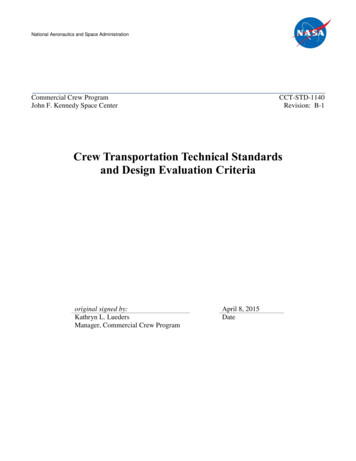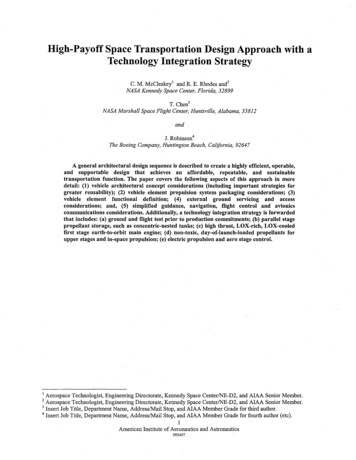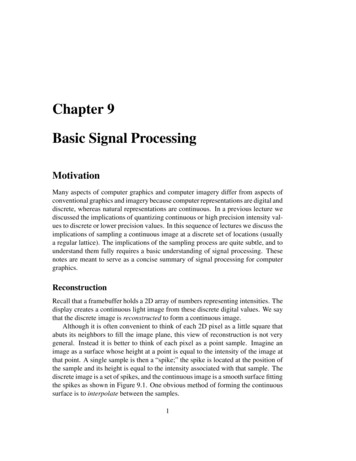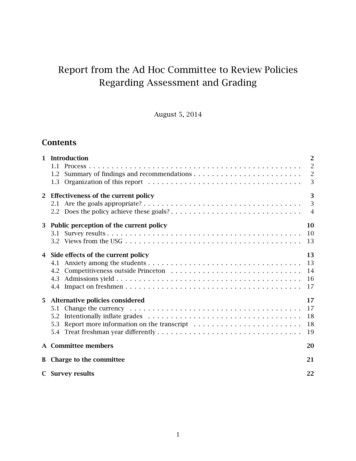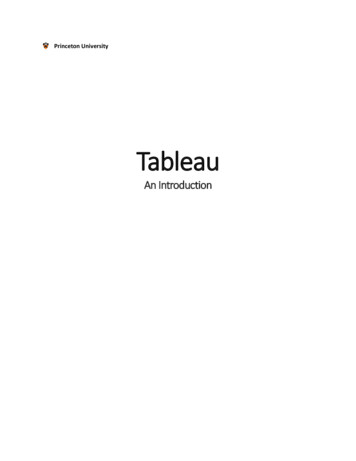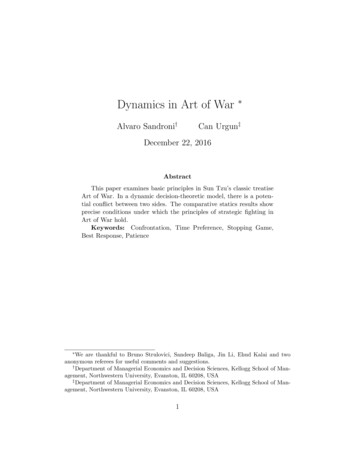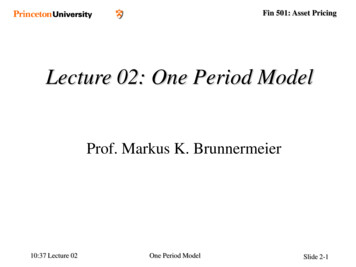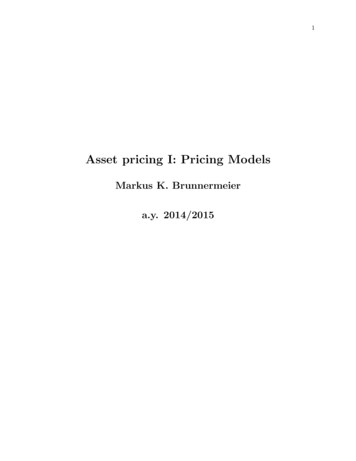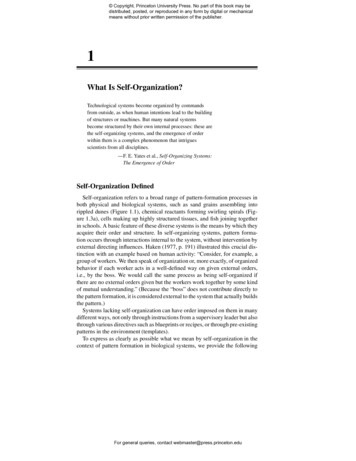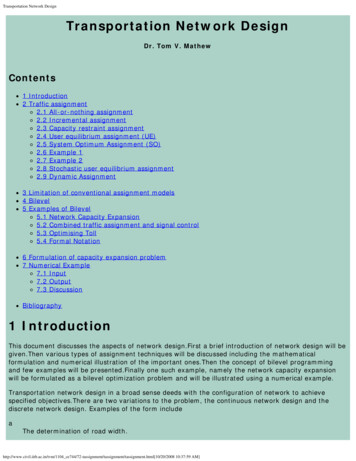
Transcription
Transportation Network DesignTransportation Network DesignDr. Tom V. MathewContents1 Introduction2 Traffic assignment2.1 All-or-nothing assignment2.2 Incremental assignment2.3 Capacity restraint assignment2.4 User equilibrium assignment (UE)2.5 System Optimum Assignment (SO)2.6 Example 12.7 Example 22.8 Stochastic user equilibrium assignment2.9 Dynamic Assignment3 Limitation of conventional assignment models4 Bilevel5 Examples of Bilevel5.1 Network Capacity Expansion5.2 Combined traffic assignment and signal control5.3 Optimising Toll5.4 Formal Notation6 Formulation of capacity expansion problem7 Numerical Example7.1 Input7.2 Output7.3 DiscussionBibliography1 IntroductionThis document discusses the aspects of network design.First a brief introduction of network design will begiven.Then various types of assignment techniques will be discussed including the mathematicalformulation and numerical illustration of the important ones.Then the concept of bilevel programmingand few examples will be presented.Finally one such example, namely the network capacity expansionwill be formulated as a bilevel optimization problem and will be illustrated using a numerical example.Transportation network design in a broad sense deeds with the configuration of network to achievespecified objectives.There are two variations to the problem, the continuous network design and thediscrete network design. Examples of the form includeaThe determination of road width.http://www.civil.iitb.ac.in/tvm/1104 10/20/2008 10:37:59 AM]
Transportation Network DesignbThe calculation of signal timings.cThe setting of road user charges.Although this document covers the continous network design in detailed, basis underlinig principles aresome form the discrete case. Conventional network design has been concerned with minimization of totalsystem cost.However, this may be unrealistic in the sense that how the user will respond to the proposedchanges is not considered. Therefore, currently the network designis thought of as supply demandproblem or leader-follower game.The system designer leads, taking into account how the user follow.The core of all network design problems is how a user chooses his route of travel. The class of trafficassignment problem tries to model these behaviour. Therefore, the traffic assignment will be discussedbefore adressing bi-level formulation of the network design problems.2 Traffic assignmentThe process of allocating given set of trip interchanges to the specified transportation system is usuallyrefered to as traffic assignment. The fundamental aim of the traffic assignment process is to reproduceon the transportation system, the pattern of vehicular movements which would be observed when thetravel demand represented by the trip matrix, or matrices ,to be assigned is satisfied. The major aims oftraffic assignment procedures are:1. To estimate the volume of traffic on the links of the network and possibly the turning movements atintersections.2. To furnish estimates of travel costs between trip origins and destinations for use in trip distribution.3. To obtain aggregate network measures, e.g. total vehicular flows, total distance covered by thevehicle, total system travel time.4. To estimate zone-to-zone travel costs(times) for a given level of demand.5. To obtain reasonable link flows and to identify heavily congested links.6. To estimate the routes used between each origin to destination(O-D) pair.7. To analyse which O-D pairs that uses a particular link or path.8. To obtain turning movements for the design of future junctions.The types of traffic assignment models are all-or-nothing assignment, incremental assignment, capacityrestraint assignment, user equilibrium assignment (UE), stochastic user equilibrium assignment (SUE),system optimum assignment (SO), etc. These frequently used models are discussed here.2.1 All-or-nothing assignmentIn this method the trips from any origin zone to any destination zone are loaded onto a single, minimumcost, path between them. This model is unrealistic as only one path between every O-D pair is utilisedeven if there is another path with the same or nearly same travel cost. Also, traffic on links is assignedwithout consideration of whether or not there is adequate capacity or heavy congestion; travel time is afixed input and does not vary depending on the congestion on a link. However, this model may bereasonable in sparse and uncongested networks where there are few alternative routes and they have alarge difference in travel cost. This model may also be used to identify the desired path : the path whichthe drivers would like to travel in the absence of congestion. In fact, this model's most importantpractical application is that it acts as a building block for other types of assignment techniques.It has alimitation that it ignores the fact that link travel time is a function of link volume and when there iscongestion or that multiple paths are used to carry traffic.http://www.civil.iitb.ac.in/tvm/1104 10/20/2008 10:37:59 AM]
Transportation Network Design2.2 Incremental assignmentIncremental assignment is a process in which fractions of traffic volumes are assigned in steps.In eachstep, a fixed proportion of total demand is assigned, based on all-or-nothing assignment. After each step,link travel times are recalculated based on link volumes. When there are many increments used, theflows may resemble an equilibrium assignment ; however, this method does not yield an equilibriumsolution. Consequently, there will be inconsistencies between link volumes and travel times that can leadto errors in evaluation measures. Also, incremental assignment is influenced by the order in whichvolumes for O-D pairs are assigned, raising the possibility of additional bias in results.2.3 Capacity restraint assignmentCapacity restraint assignment attempts to approximate an equilibrium solution by iterating between allor-nothing traffic loadings and recalculating link travel times based on a congestion function that reflectslink capacity. Unfortunately, this method does not converge and can flip-flop back and forth in loadingson some links.2.4 User equilibrium assignment (UE)The user equilibrium assignment is based on Wardrop's first principle, which states that no driver canunilaterally reduce his/her travel costs by shifting to another route. If it is assumed that drivers haveperfect knowledge about travel costs on a network and choose the best route according to Wardrop's firstprinciple, this behavioural assumption leads to deterministic user equilibrium. This problem is equivalentto the following nonlinear mathematical optimization program,(1)k is the path,equilibrium flows in link a,O-D pair r-s,trip rate between r and s.travel time on link a,flow on path k connectingThe equations above are simply flow conservation equations and non negativity constraints, respectively.These constraints naturally hold the point that minimizes the objective function. These equations statehttp://www.civil.iitb.ac.in/tvm/1104 10/20/2008 10:37:59 AM]
Transportation Network Designuser equilibrium principle.The path connecting O-D pair can be divided into two categories : thosecarrying the flow and those not carrying the flow on which the travel time is greater than (or equal to)theminimum O-D travel time. If the flow pattern satisfies these equations no motorist can better off byunilaterally changing routes. All other routes have either equal or heavy travel times. The userequilibrium criteria is thus met for every O-D pair. The UE problem is convex because the link travel timefunctions are monotonically increasing function, and the link travel time a particular link is independent ofthe flow and other links of the networks. To solve such convex problem Frank Wolfe algorithm is useful.2.5 System Optimum Assignment (SO)The system optimum assignment is based on Wardrop's second principle, which states that driverscooperate with one another in order to minimise total system travel time. This assignment can bethought of as a model in which congestion is minimised when drivers are told which routes to use.Obviously, this is not a behaviourally realistic model, but it can be useful to transport planners andengineers, trying to manage the traffic to minimise travel costs and therefore achieve an optimum socialequilibrium.(2)equilibrium flows in link a,travel time on link a,flow on path k connecting O-D pair r-s,trip rate between r and s.2.6 Example 1To demonstrate how the most common assignment works, an example network is considered. Thisnetwork has two nodes having two paths as links.Let us suppose a case where travel time is not a function of flow as shown in other words it is constant asshown in the figure below.http://www.civil.iitb.ac.in/tvm/1104 10/20/2008 10:37:59 AM]
Transportation Network DesignFigure 1: Two Link Problem with constant travel time function2.6.1 All or nothingThe travel time functions for both the links is given by:and total flows from 1 to 2.Since the shortest path is Link 1 all flows are assigned to it making 12 and 0.2.6.2 User EquilibriumSubstituting the travel time in equations 1 - 5 yield toSubstituting, in the above formulation will yield the unconstrained formulation ashttp://www.civil.iitb.ac.in/tvm/1104 10/20/2008 10:37:59 AM]
Transportation Network Designbelow :Differentiate the above equation w.r.tto the solution 12,and equate to zero, and solving forand thenleadsand thenleads 0.2.6.3 System OptimizationSubstituting the travel time in equation: (6-8), we get the following:Substitutingthe above formulations takes the following form:Differentiate the above equation w.r.tto the solution 12,and equate to zero, and solving for 0, and 120.2.6.4 Comparison of resultsAfter solving each of the formulations the results are tabulated in Table 1. One can infer that if the traveltime is independent of the flow, then essentially there in no difference between the various assignmenttypes.Table 1: Comparison of results for example 20120http://www.civil.iitb.ac.in/tvm/1104 10/20/2008 10:37:59 AM]
Transportation Network Design2.7 Example 2Figure 2: Two Link Problem with variable travel time functionLets now take a case where travel time functions for both the links is given by:and total flows from 1 to 2.2.7.1 All or Nothing AssignmentAssumewhich makesflows are assigned to it making 12 and0 and 0.2.7.2 User EquilibriumSubstituting the travel time in equations 1 - 5 yield tohttp://www.civil.iitb.ac.in/tvm/1104 10/20/2008 10:37:59 AM]. Since the shortest path is Link 1 all
Transportation Network DesignSubstituting, in the above formulation will yield the unconstrained formulation asbelow:Differentiate the above equation w.r.tto the solution 5.8,and equate to zero, and solving for 6.2.2.7.3 System OptimizationSubstituting the travel time in equation: (6-8), we get the tvm/1104 10/20/2008 10:37:59 AM]and thenleads
Transportation Network DesignDifferentiate the above equation w.r.t zero, and solving for 5.3, 6.7, andand thenleads to the solution 327.55.2.7.4 Comparison of resultsAfter solving each of the formulations the results are tabulated in Table 2. One can infer that unlikeearlier, the various assignment types shows considerable differences in the performace. AON hasobviously the worst solution and SO has the best.Table 2: Comparison of results for example 2TSTTTypeAON1015120467.44552UE27.4 27.45.86.2239.0328.8SO30.1 25.65.36.7327.5327.52.8 Stochastic user equilibrium assignmentUser equilibrium assignment procedures based on Wardrop's principle assume that all drivers percievecosts in an identical manner. A solution to assignment problem on this basis is an assignment such thatno driver can reduce his journey cost by unilaterally changing route. Van Vilet considered as stochasticassignmnet models, all those models which explicitly allows non minimum cost routes to be selected.Virtually all such models assume that drivers perception of costs on any given route are not identical andthat the trips between each O-D pair are divided among the routes with the most cheapest routeattracting most trips. They have important advantage over other models because they load many routesbetween individual pairs of network nodes in a single pass through the tree building process,theassignments are more stable and less sensitive to slight variations in network definitions or link costs tobe independent of flows and are thus most appropriate for use in uncongested traffuc conditions such asin off peak periods or lightly trafficked rural areas.2.9 Dynamic AssignmentDynamic user equilibrium,expressed as an extension of Wardrop's user equilibrium principle, may bedefined as the state of equilibrium which arises when no driver an reduce his disutility of travel bychoosing a new route or departure time,where disutility inclues, schedule delay in addition in to costsgenerally considered. Dynamic stochastic equilibrium may be similarly defined in terms of percievedutility of travel. The existence of such equilibria in complex networks has not been proven theoretical andeven if they exist the question of uniqueness remains open.3 Limitation of conventional 04 10/20/2008 10:37:59 AM]
Transportation Network DesignThe specific limitations of the assignment models are highlighted below.1. Most of the cost functions, such
This document discusses the aspects of network design.First a brief introduction of network design will be given.Then various types of assignment techniques will be discussed including the mathematical formulation and numerical illustration of the important ones.Then the concept of bilevel programming
